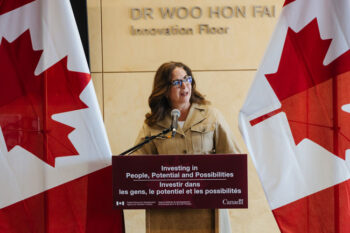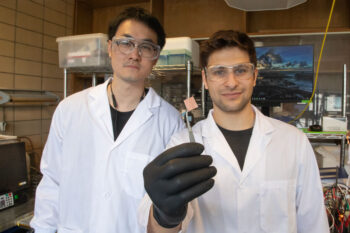Renewable energy sources such as wind and solar may solve a world of energy worries — if we can only figure out how to store their energy efficiently. Researchers from academia and industry joined forces to consider this and other future energy challenges at the inaugural research showcase of the Centre for Power & Information (CPI), hosted by The Edward S. Rogers Sr. Department of Electrical & Computer Engineering (ECE) on Monday, April 18.
Storage is one challenge of renewables, but predictability is another: power grid operators need more reliable forecasts of when to expect surges of renewable energy into the grid. Professor Zeb Tate (ECE) and his group look at the effect of renewable generation technologies on the reliable operation of the power grid. He presented a new tool that allows grid operators to identify transmission-line overloads that may arise due to forecast errors in renewable generation.
“Wind and solar generation are displacing traditional generators, making it difficult to anticipate problems on the system and making it harder to manage frequency — with traditional operating regimes, both of these issues could lead to a reduction in grid reliability,” said Professor Tate. “Our research looks at ways to ensure this doesn’t happen.”
And while challenges related to integration of renewable generation are top of mind to researchers in the CPI, so too are problems of cyber-physical system security. Professor Deepa Kundur (ECE), director of the Centre for Power & Information, outlined the emerging challenges of cyber protecting the ‘smart grid’ as it grows in its degree of complexity, connectivity and automation. She presented systems-based frameworks for modelling cyber-physical interactions for vulnerability and risk analysis. While cyber security is a process, it should be an integral part of system design, she said. The challenge is balancing security without hindering usability.
More than 80 people attended the showcase, which featured industry-focused research talks from ECE researchers and hands-on demonstrations.
“The Centre for Power & Information is in a unique position to address shifting and fluid energy issues related to future power grids,” said Professor Kundur. “Our aim is to achieve this through fundamental research while collaborating with industry and with other fields — a true multidisciplinary centre.”
Other speakers included:
- Professor Ben Liang’s (ECE) talk focused on the problem of power balancing in a general renewable-integrated power grid with storage and flexible loads.
- Professor Steve Mann (ECE) presented his team’s recent work on visualization.
- Professor Josh Taylor (ECE) spoke about a new market mechanism to increase the economic viability of energy storage. He proposed that allowing energy storage into the electricity markets in the same manner as transmission lines will help to encourage the adoption of storage in power systems — an essential aspect for renewable energy integration.



